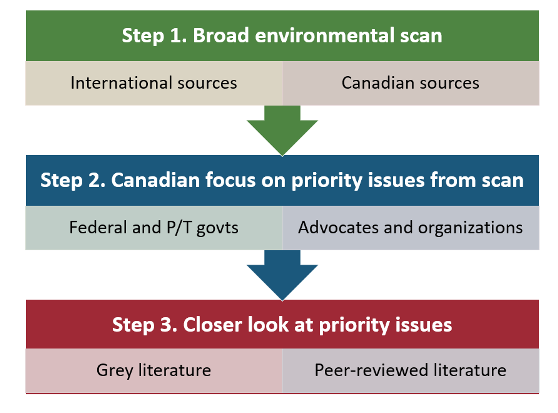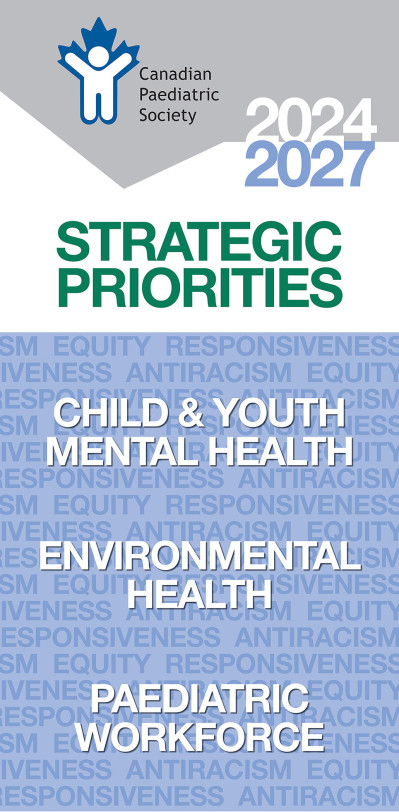Strategic Priorities: 2024-2027
Strategic Priorities Working Group
- Dr Jared Bullard, Board member
- Dr Jeff Critch, CPS President (2023-24)
- Dr Kelly Cox, Board member
- Dr Mark Feldman, CPS Past President
- Dr Johanne Harvey, CPS President (2024-25)
- Dr Anne Rowan-Legg, Board member
- Dr Sam Wong, Medical Affairs Director
- Marie Adèle Davis, Executive Director
- Jackie Millette, Associate Executive Director, Education & National Programs
- Elizabeth Moreau, Associate Executive Director, Communications & Strategic Priorities
In June 2024, the Canadian Paediatric Society announced its priorities for the coming three years. These priorities are the result of a year-long period of reflection, research, and consultation. They express what we believe to be among the most urgent issues facing children and youth in Canada, problems that require a sustained, multi-faceted, and collaborative approach, and where the CPS can make a difference:
- Child and youth mental health
- Environmental health
- Paediatric workforce
We believe that nothing is more important than the health and well-being of children and youth. To prioritize child and youth health, we must create communities, environments, and systems that help them thrive.
We believe that addressing these priority issues over the coming years will help support all children, youth, and families in Canada as well as the health professionals who care for them.
Read more below:
This document is also available as a pdf.
Areas of focus
Child and youth mental health
Mental health is fundamental to growth and development and has become an increasing focus of paediatricians’ work in recent years. For 2024 to 2027, the CPS will prioritize three aspects of child and youth mental health:
- Screen use: Frequent, intensive use of digital media by children and youth can influence health and development, and mental health in particular. Screens are ubiquitous in the lives of children and youth and in most places they live, learn, and play. Young people must be protected from potential harms associated with digital media use, which can outweigh its many benefits for enhanced learning and development.
- Mental health professionals and services: Many children and youth in Canada need help with a mental or behavioural health concern, and timely intervention is critical to outcome. Yet access to appropriate mental health services is difficult for many families and limited by location in Canada and ability to pay.
- Chronic and complex conditions: Children and youth living with a physical or developmental health condition are more likely than their peers to also experience a mental health problem. Managing a chronic or complex illness can take a toll on individual and family well-being, and ensuring access to integrated supports is critical for overall health.
In each of these areas, the CPS will collaborate with allies, decision-leaders, and stakeholders to improve mental health care through advocacy, action, and access to services.
Environmental health
Threats posed by climate change are a leading concern for the health sector, with children being especially vulnerable to its most familiar environmental effects, such as changing patterns of infectious diseases, air pollution, rising temperatures, and wildfires. The CPS will act on three levels to help address the impacts of climate change on children and youth:
- Physician education and support: Paediatricians need to understand the health effects of climate change on young people and how best to mitigate them. They also need information and resources to counsel families on effects and precautions.
- Advocacy and collaboration: The CPS will actively promote planetary health and healthier living and play environments for children and youth. We will work with others to help influence public policy on climate and environmental health.
- Organizational change: We will take measures to reduce our own impact on the environment.
Paediatric workforce
The practice of paediatrics, like other areas of the Canadian health care system, is under stress. As the only national organization representing paediatricians in Canada, the CPS has a unique responsibility to advocate for a healthier workforce. This means training enough paediatricians and subspecialists to meet the changing needs of children and youth, and ensuring they have the means to work collaboratively with other health professionals involved in paediatric care. The CPS will engage and partner with other organizations to improve a number of metrics:
- Data collection: We need a clearer picture of current paediatric health care environments, including the number and scope of practitioners, their location, and the needs of children and youth.
- Aligning workforce capacity with patient needs: We need to ensure that future paediatricians are trained to meet the specific, evolving needs of children and youth, both in team environments and integrated settings with other health professionals.
- Decreasing administrative burden: Physicians spend too much time filling in forms and providing information to third parties, such as insurance companies and governments, to the detriment of patient care.
Guiding principles
These principles have shaped the development of our strategic priorities, and will be reflected in all of our actions:
Antiracism
Racism is a pervasive problem in Canada, and a child and youth health problem. Racism is harmful to children’s mental health and development.
Racism is a systemic problem. Even if we don’t always recognize racism, it is embedded in our systems, policies, practices, and language. This includes the health care system.
The CPS is working to be an actively antiracist organization and committed to addressing racism in paediatric practice, in our institutions, and in communities.
Equity
A child’s life circumstances should not hinder their ability to grow, develop, and learn. The CPS works to ensure equity for all children and youth, regardless of where they live or who they are. We also realize that not all solutions and approaches suit all children, youth, and families. Optimal health care always considers a family’s culture and living environment.
For each priority area, the CPS will consider the needs of specific populations, including First Nations, Inuit and Métis children and youth, newcomers to Canada, and families living in poverty.
Responsiveness
Strategic priorities help to focus the work of the CPS, but they do not represent the full scope of our activities. We will continue to be active in many other areas and respond to the emerging needs of children, youth, and the health professionals who care for them.
Context
Our 2024-2027 priorities build on our 2017-2022 strategic framework, and they reflect the current realities of children, youth, and families, which are quite different from just a few years ago.
- We live in a ‘post-pandemic’ environment: Much has changed since 2020, when lives were disrupted by COVID-19. Public health measures, including school closures and restrictions on community activities, disproportionately affected children and youth, and evidence for the impacts of those measures continues to emerge. Among other effects, the pandemic years contributed to increased use of digital media, a rise in social disconnectedness and isolation, and academic losses. We also witnessed polarizing debates about vaccines, and increasing spread of health misinformation.
- Families are under increased economic stress: Inflation in recent years has affected nearly every aspect of family spending, from groceries to gas. Families must make difficult choices or change their living habits to make ends meet. For some, this means fewer nutritious foods or no extracurricular activities. Higher costs of daily living, coupled with housing shortages, are additional strains for many families. Economic stress can have negative effects on the mental health of adults and children alike.
- Canada is experiencing a health workforce crisis: Paediatricians report increasingly complex patient populations presenting with heightened acuity and needing multidisciplinary specialized care, and mental health or social support. When more than 6.5 million Canadian do not have access to a family physician, preventive care, timely diagnosis and treatment, and continuity of care are inaccessible for many. This crisis in primary care affects every aspect of Canada’s health care system, including paediatrics.
Our process

Much has changed for Canada’s children and youth since the last strategic framework launched in 2017. To ensure the process of determining strategic priorities was grounded in evidence and responsive to the needs of CPS members, we undertook a year-long research and consultation process.
The first step was a broad environmental scan to identify trends in child and youth health, both in Canada and in comparable countries. Initial research questions and appropriate resources were identified, scanned, and prioritized as information emerged.
Our guiding question was: What factors are influencing the healthy development of children and youth in Canada?
We reviewed key international sources—global organizations involved with child and youth health, professional paediatric societies, and organizations focused on child and youth health in Australia, New Zealand, the United Kingdom, and the United States.
Canadian sources included: federal and provincial/territorial governments; national child/youth health organizations; and provincial/territorial child advocates. We looked for similarities and differences in focus, and what factors might explain these.
Finally, we examined both grey and peer-reviewed literature to understand some of the drivers of priority issues.
To narrow the list of potential priorities for the CPS, we reflected on who we are as an organization, our particular strengths, and what can realistically be achieved over a three-year period.
We presented findings to the Board of Directors for validation, then consulted with members involved with leadership groups—committees, sections, and task forces—then engaged the entire membership.
Thanks to member expertise and experience, each step helped us better understand potential priorities from a range of perspectives.
For more information or to comment: info@cps.ca
Last updated: Nov 20, 2024

